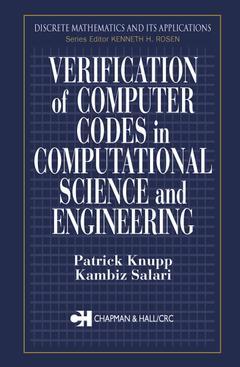Description
Verification of Computer Codes in Computational Science and Engineering
Discrete Mathematics and Its Applications Series
Authors: Knupp Patrick, Salari Kambiz
Language: English
Subjects for Verification of Computer Codes in Computational Science...:
Keywords
Coding Mistakes; mistake; Discretization Error; exact; Governing Equations; solution; Coverage Tests; discretization; Exact Solution; error; Interior Equations; partial; Numerical Algorithm; differential; Grid Refinement; equation; Manufactured Solutions; numerical; Boundary Condition Types; algorithm; Lax Equivalence Theorem; Discrete Solution; Source Term; Norm Error Ratio; Dirichlet Boundary Condition; Code Capabilities; Boundary Condition; Finite Difference Methods; Code Verification; Normalized Global Error; Navier Stokes Code; Dissipation Terms; Artificial Dissipation Terms; Radiation Transport Equations; Grid Convergence Testing
184.47 €
Subject to availability at the publisher.
Add to cart144 p. · 15.6x23.4 cm · Hardback
Description
/li>Contents
/li>Readership
/li>Biography
/li>
How can one be assured that computer codes that solve differential equations are correct? Standard practice using benchmark testing no longer provides full coverage because today's production codes solve more complex equations using more powerful algorithms. By verifying the order-of-accuracy of the numerical algorithm implemented in the code, one can detect most any coding mistake that would prevent correct solutions from being computed.
Verification of Computer Codes in Computational Science and Engineering sets forth a powerful alternative called OVMSP: Order-Verification via the Manufactured Solution Procedure. This procedure has two primary components: using the Method of Manufactured Exact Solutions to create analytic solutions to the fully-general differential equations solved by the code and using grid convergence studies to confirm the order-of-accuracy. The authors present a step-by-step procedural guide to OVMSP implementation and demonstrate its effectiveness.
Properly implemented, OVMSP offers an exciting opportunity to identify virtually all coding 'bugs' that prevent correct solution of the governing partial differential equations. Verification of Computer Codes in Computational Science and Engineering shows you how this can be done. The treatment is clear, concise, and suitable both for developers of production quality simulation software and as a reference for computational science and engineering professionals.




